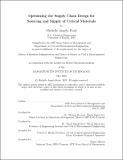Optimizing the Supply Chain Design for Sourcing and Supply of Critical Materials
Author(s)
Feole, Michelle Angela
DownloadThesis PDF (4.162Mb)
Advisor
Simchi-Levi, David
Roemer, Thomas
Terms of use
Metadata
Show full item recordAbstract
A significant supply disruption occurred in 2019 from a packaging component supply shortage, impacting sites and products globally across the AstraZeneca (AZ) network. Supply to patients continued; however, a team was created to then manage the supply of critical materials. These materials are typically single sourced and used commonly across multiple AZ sites and brands signifying that a disruption could impact patient supply and AZ revenue across multiple brands. This thesis focuses on providing a framework for evaluating risk and vulnerabilities in the sourcing of the critical material supply chain design with a focus on primary packaging. With this methodology, users can identify opportunities for developing a more flexible and resilient supply chain.
After analyzing a subset of Stock-Keeping Units (SKUs). and segmenting them based on complexity and criticality, we applied the Time-to-Survive (TTS) and Time-to-Recover (TTR) framework to identify high risk materials and supply nodes. TTR is the time for a supply chain to recover after a disruption at a particular node. TTS is the time the supply chain can continue operations based on demand and inventory levels. A TTS/TTR tool was created to index and sort the high risk materials supplemented by a process for interpreting the outputs and mitigations. After identifying the areas of risk, we also proposed a method for analyzing the trade-off between dual-sourcing versus holding increased inventory by evaluating the potential return on assets (ROA) ratio.
Date issued
2022-05Department
Sloan School of Management; Massachusetts Institute of Technology. Department of Civil and Environmental EngineeringPublisher
Massachusetts Institute of Technology